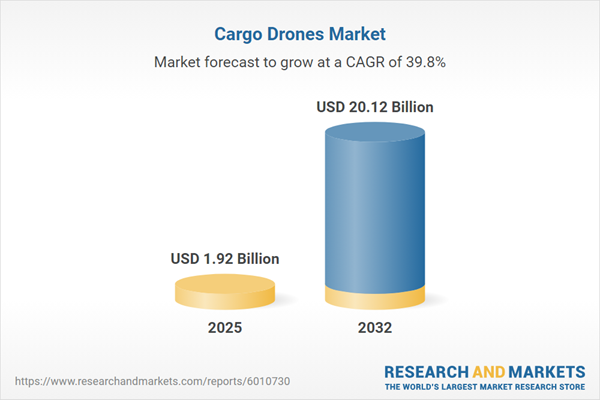Speak directly to the analyst to clarify any post sales queries you may have.
The cargo drones market is entering a transformative period as organizations seek efficient, resilient, and scalable solutions for aerial logistics. As adoption accelerates across industries, understanding the market’s evolving dynamics is essential for senior decision-makers.
Market Snapshot: Cargo Drones Market Growth and Outlook
The Cargo Drones Market grew from USD 1.38 billion in 2024 to USD 1.92 billion in 2025. It is expected to continue expanding at an impressive compound annual growth rate of 39.75%, reaching USD 20.12 billion by 2032. Market expansion is fueled by innovation in unmanned aerial vehicles, shifting regulatory frameworks, and widespread demand for rapid and dependable airborne logistics across multiple sectors.
Cargo Drones Market: Scope & Segmentation
This comprehensive report evaluates the global cargo drones market across the following key dimensions:
- Drone Types: Fixed-wing (including blended wing body and straight wing), hybrid (tilt rotor and tilt wing), and multi-rotor models (hexacopter, octocopter, quadcopter, tricopter).
- Payload Capacity: Above 10kg, below two kg, five to ten kg, and two to five kg.
- Range: Long, medium, and short-range categories tailored to diverse operational requirements.
- Application Areas: E-commerce delivery, food delivery, industrial logistics, medical supply transport, and postal services.
- Power Source: Battery electric, fuel cell, and hybrid electric propulsion solutions.
- End User Sectors: Agriculture, e-commerce, government and defense, healthcare, manufacturing, and retail.
- Regions: Americas (North America and Latin America), Europe, Middle East, Africa, and Asia-Pacific. Coverage includes the United States, Canada, Brazil, United Kingdom, Germany, China, India, Japan, Australia, South Africa, and other strategic markets.
- Key Companies: Amazon.com, Zipline International, Volocopter, Wing Aviation, Drone Delivery Canada, Wingcopter, Matternet, Volansi, Elroy Air, and Flytrex Aviation.
Technological advancements covered include modular airframes, autonomous flight controls, advanced powertrains, and infrastructure for scale, such as vertiports and battery swap stations.
Key Takeaways for Decision-Makers
- Recent technical innovations—such as improved propulsion and AI-guided navigation—are driving performance improvements, allowing cargo drones to serve new logistics segments and mission types.
- Integration of drones with established logistics networks is increasing supply chain agility, providing end users with adaptable solutions for both urban and remote settings.
- Collaborative ventures between technology firms and established aerospace players are lowering barriers to market entry, expediting deployment, and enhancing competitive positioning.
- Regional policies and regulatory harmonization, particularly in Europe and Asia-Pacific, are crucial for scaling operations and enabling cross-border drone corridors.
- Sustainability initiatives, including the use of recyclable materials and low-emission powertrains, are aligning drone programs with broader corporate responsibility objectives.
Tariff Impact and Supply Chain Adjustments
Recent tariffs imposed by the United States on key drone components in 2025 have triggered rapid realignment of supply chains. Manufacturers are diversifying sourcing strategies, including increased reliance on domestic suppliers, to mitigate cost pressures and ensure continuity. These adjustments have sparked new co-development initiatives and flexible contractual arrangements with end users, enabling the industry to maintain momentum amid changing trade dynamics.
Methodology & Data Sources
This report employs a multi-phase research methodology, combining primary insights from industry interviews with extensive secondary analysis of regulatory documentation, technical literature, and market disclosures. Quality assurance protocols verify data consistency and minimize bias. Scenario analysis was used to test supply chain resilience and future-proof conclusions for senior stakeholders.
Why This Report Matters
- Offers decision-ready insights on the evolving cargo drones landscape, enabling informed investment, partnership, and technology roadmaps.
- Delivers a granular view of key segments, regional dynamics, and emerging technologies to guide targeted market entry or expansion strategies.
- Equips leaders with actionable understanding of regulatory and commercial risks, supporting resilient and compliant platform deployment.
Conclusion
Cargo drones continue to reshape the future of logistics by integrating advanced technology, responsive supply chains, and robust ecosystem partnerships. This report distills the market’s complexity into actionable strategy, supporting competitive advantage and sustainable growth across global regions.
Additional Product Information:
- Purchase of this report includes 1 year online access with quarterly updates.
- This report can be updated on request. Please contact our Customer Experience team using the Ask a Question widget on our website.
Table of Contents
3. Executive Summary
4. Market Overview
7. Cumulative Impact of Artificial Intelligence 2025
Companies Mentioned
The companies profiled in this Cargo Drones market report include:- Amazon.com, Inc.
- Zipline International Inc.
- Volocopter GmbH
- Wing Aviation LLC
- Drone Delivery Canada Corp.
- Wingcopter GmbH
- Matternet, Inc.
- Volansi, Inc.
- Elroy Air, Inc.
- Flytrex Aviation Ltd.
Table Information
| Report Attribute | Details |
|---|---|
| No. of Pages | 189 |
| Published | November 2025 |
| Forecast Period | 2025 - 2032 |
| Estimated Market Value ( USD | $ 1.92 Billion |
| Forecasted Market Value ( USD | $ 20.12 Billion |
| Compound Annual Growth Rate | 39.7% |
| Regions Covered | Global |
| No. of Companies Mentioned | 11 |









